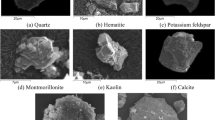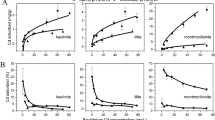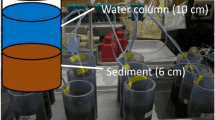Abstract
Bays, lagoons, and estuaries are sites where normal physicochemical processes result in accumulations of sediment and certain chemicals. Changes in water velocity and chemistry, and chemical interactions of sediment, biota, and water are factors that contribute to concentrating trace metals in coastal and lake sediments.
To evaluate whether lead concentration is affected by mineralogy, kaolinite, illite, montmorillonite, and a zeolitic tuff were suspended in 10 and 20 mg/l concentrations of lead solutions [Pb(NO3)2] which were pH-adjusted incrementally through a range of 2.5 to 11.0. Samples were centrifuged after 24 hours to separate liquid from suspended sediment. Sediment-free solutions were run as controls. Lead concentrations were determined by atomic adsorption spectrophotometry.
Results indicate that montmorillonite (Wyoming Bentonite) particles serve as lead adsorption nuclei over a broad pH range. Maximum sorption occurs as the solution reaches a pH of about 7.5. The kaolinite clay from Georgia strongly adsorbs trace amounts of lead at pH ranging from 3.0 to 4.5, where up to 95 percent of the lead is adsorbed by the clay.
Little adsorption difference was found between the Fithian illite clay and zeolitic tuff from the Nevada Test Site in comparison to sediment-free solutions which were pH-adjusted.
In concentrations of 10 to 20 mg/l montmorillonite and kaolinite clays serve as nucleation sites capable of adsorbing up to 95 percent of trace concentrations of lead within 24 hours. It appears that accumulations of lead in coastal lake and estuarine sediments are significantly influenced by:
-
1.
pH changes which occur as river and coastal waters mix resulting in precipitation of lead, and
-
2.
sorption of lead by suspended clays.
Similar content being viewed by others
References
Bopp, Frederick, III, F. K. Lepple, and R. B. Biggs, 1972, Trace metal baseline studies on the Murderkill and St. Jones Rivers, Delaware coastal plain: Univ. Delaware, Newark, College of Marine Sciences, DelSG-10-72, 31 p.
Caldwell, O. G., and C. E. Marshall, 1942, A study of some chemical and physical properties of the clay minerals nontronite, attapulgite, and saponite: Missouri Univ. Agricultural Experimental Sta. Research Bull., 354 p.
Grim, R. E., 1968, Clay mineralogy: New York, McGraw-Hill, 195 p.
Hauser, E., and C. E. Reed, 1937, Studies in thixotropy, II: the thixotropic behavior and structure of bentonite: Jour. Physical Chemistry, v. 41, p. 911–934.
Hildebrand, E. E., and W. E. Blum, 1974, Layering fixation by clay minerals: Naturwissenshaften, v. 61, p. 169.
Kennedy, E. J., R. R. Ruch, and N. F. Shimp, 1972, Distribution of mercury in unconsolidated sediments from southern Lake Michigan: Illinois Geol. Survey, Environmental Geology Notes, No. 44, 18 p.
Leland, H. V., S. S. Shukla, and N. F. Shimp. 1973, Factors affecting distribution of lead and other trace metals in sediments of southern Lake Michigan,in Singer, P. C., ed., Trace metals and metal-organic interactions in natural waters: Ann Arbor. Michigan, Ann Arbor Science Pub., Inc., p. 89–130.
Ruch, R. R., E. J. Kennedy, and N. F. Shimp. 1970, Distribution of arsenic in unconsolidated sediments from southern Lake Michigan: Illinois Geol. Survey, Environmental Geology Notes, No. 37, 16 p.
Scrudato, R. J., and D. L. Brown, 1972. Effects of heavy metals on water quality of Sabine Lake (Abs.): Texas Academy of Sciences, Houston, Texas Mtg., Prog. with Abstracts.
Shimp, N. F., H. V. Leland and W. A. White, 1970, Distribution of major, minor and trace constituents in unconsolidated sediments from southern Lake Michigan: Illinois Geol. Survey, Environmental Geology Notes, No. 32, 19 p.
Author information
Authors and Affiliations
Rights and permissions
About this article
Cite this article
Scrudato, R.J., Estes, E.L. Clay-lead sorption relations. Geo 1, 167–170 (1975). https://doi.org/10.1007/BF02428944
Received:
Revised:
Issue Date:
DOI: https://doi.org/10.1007/BF02428944




